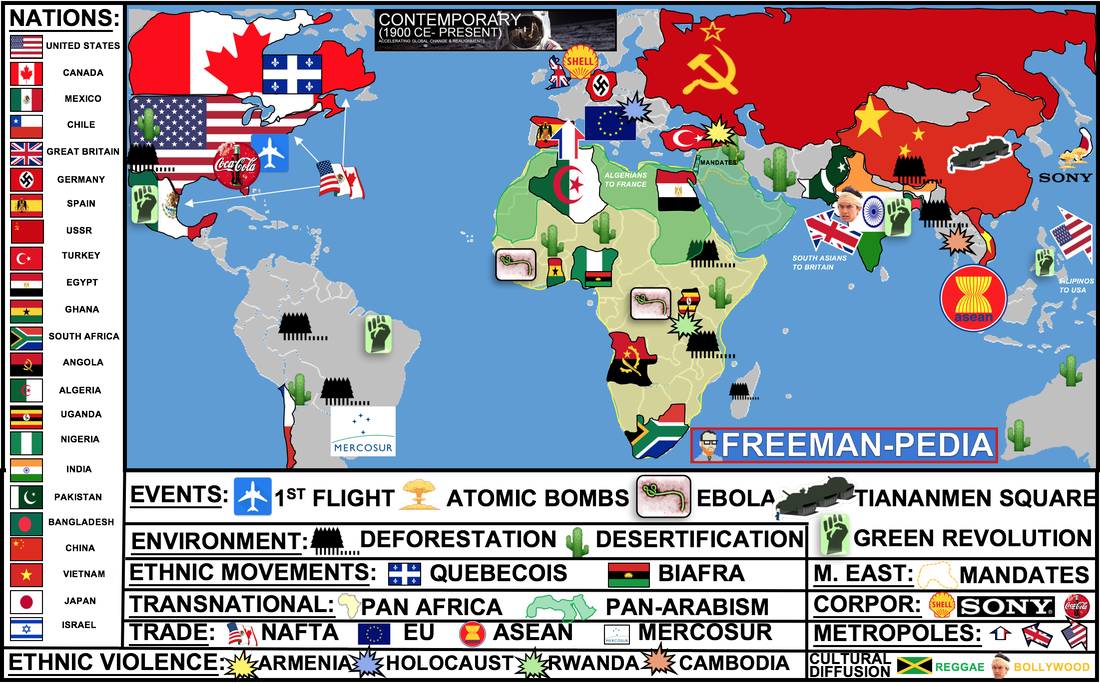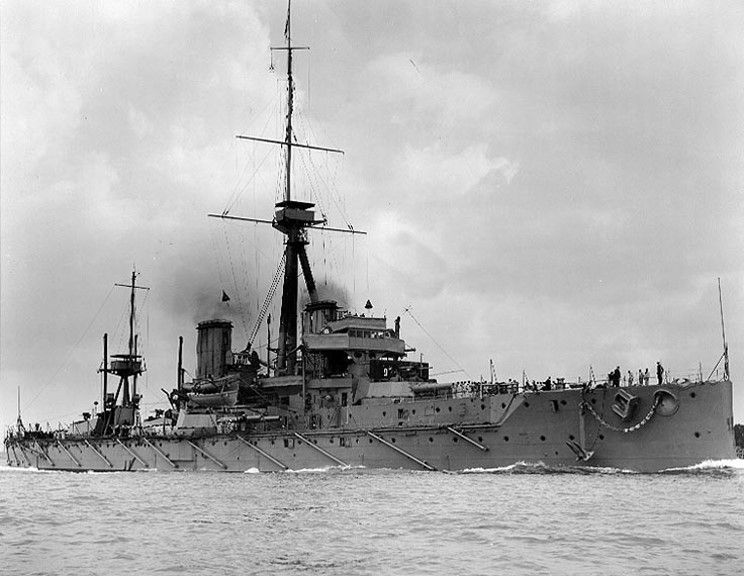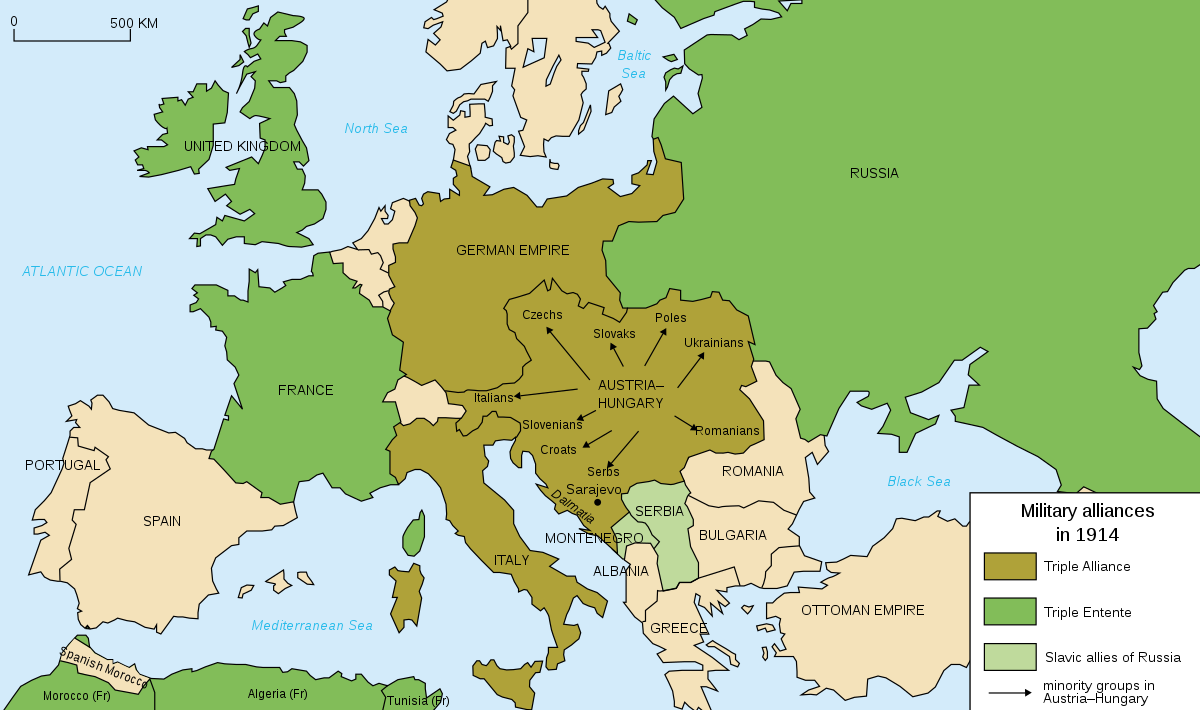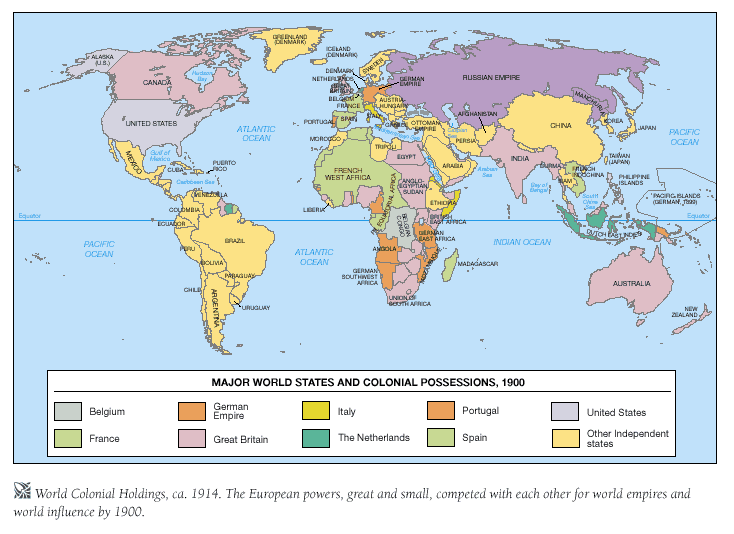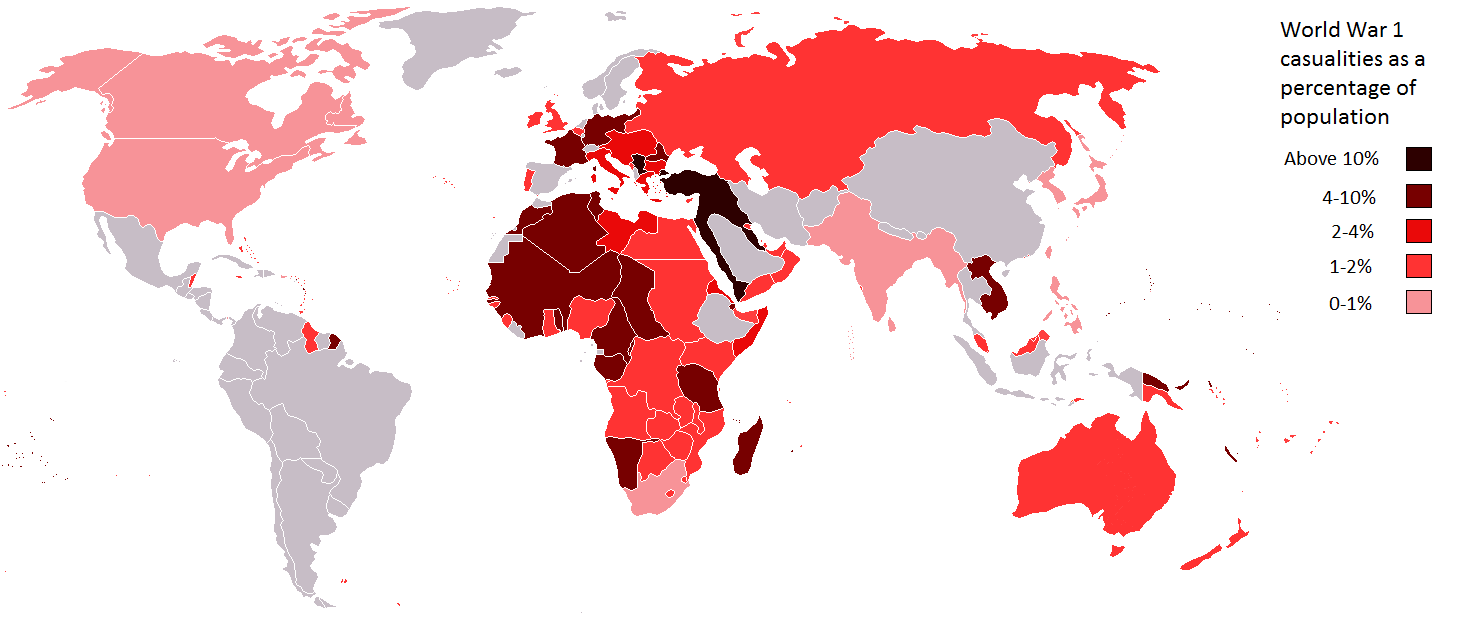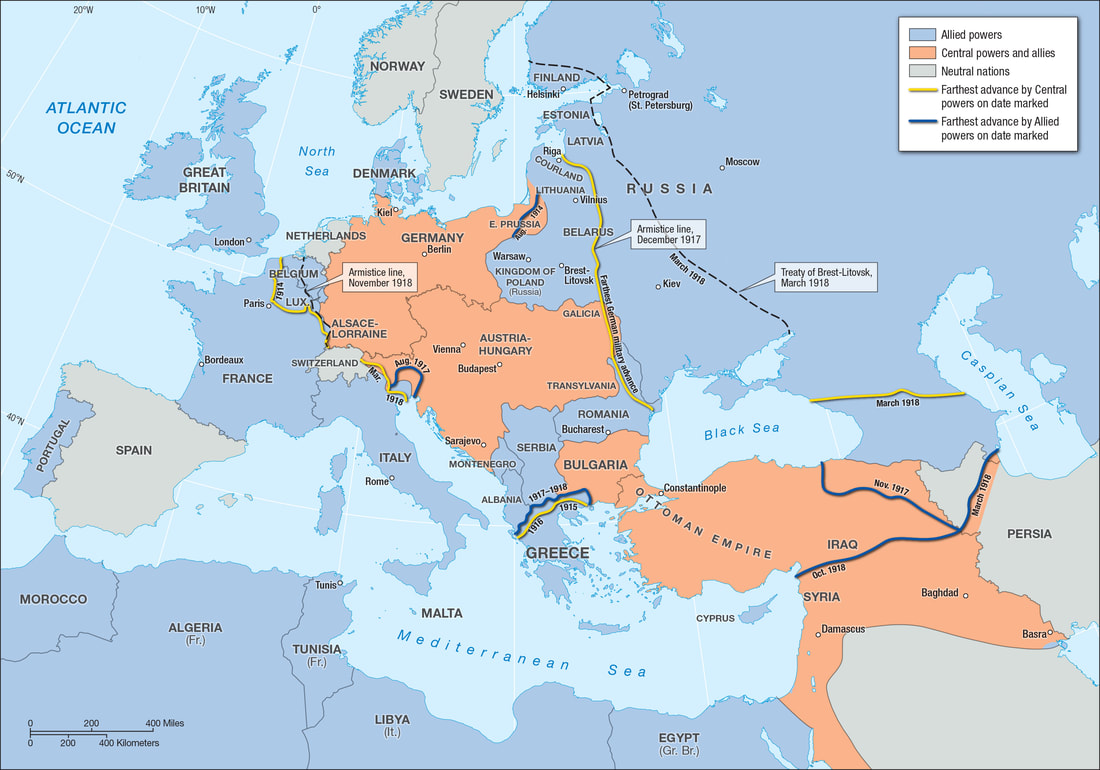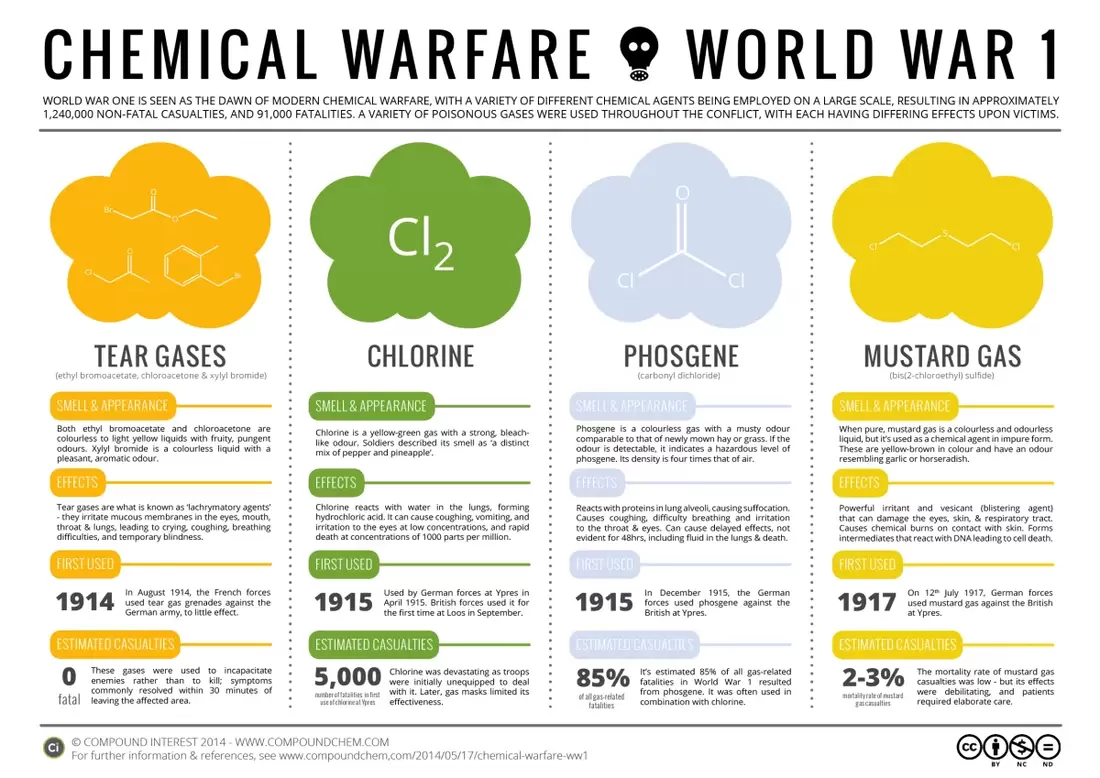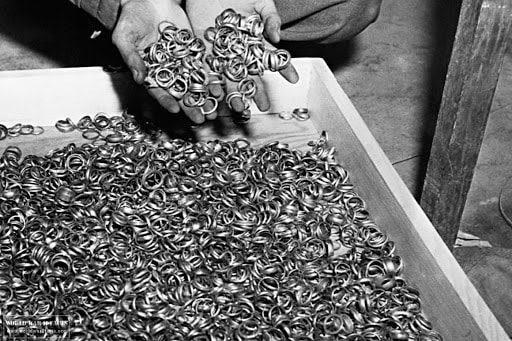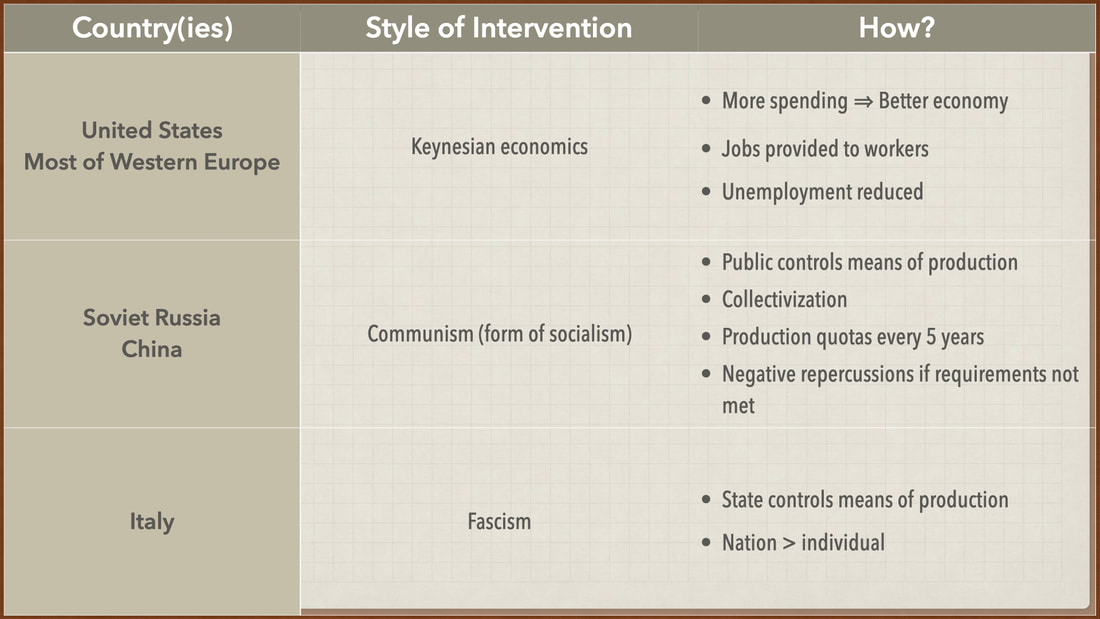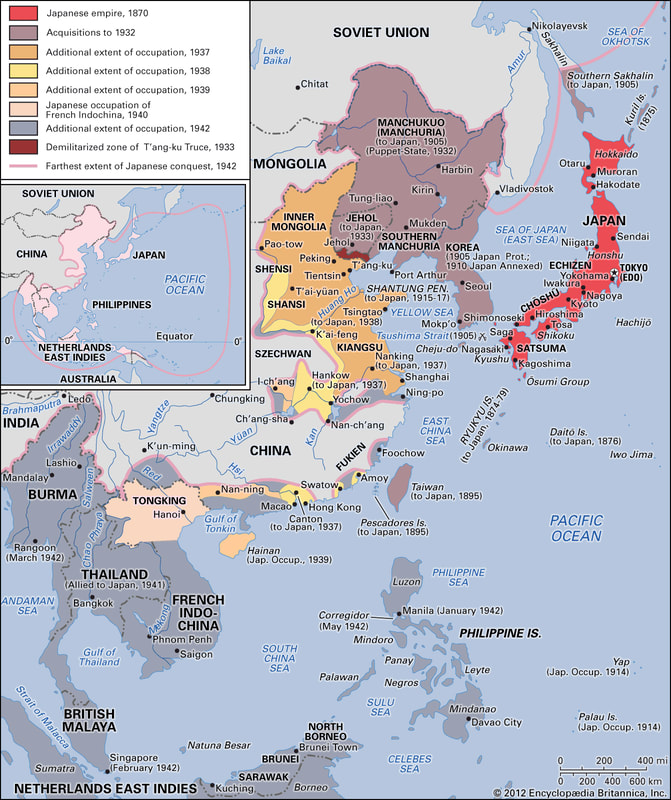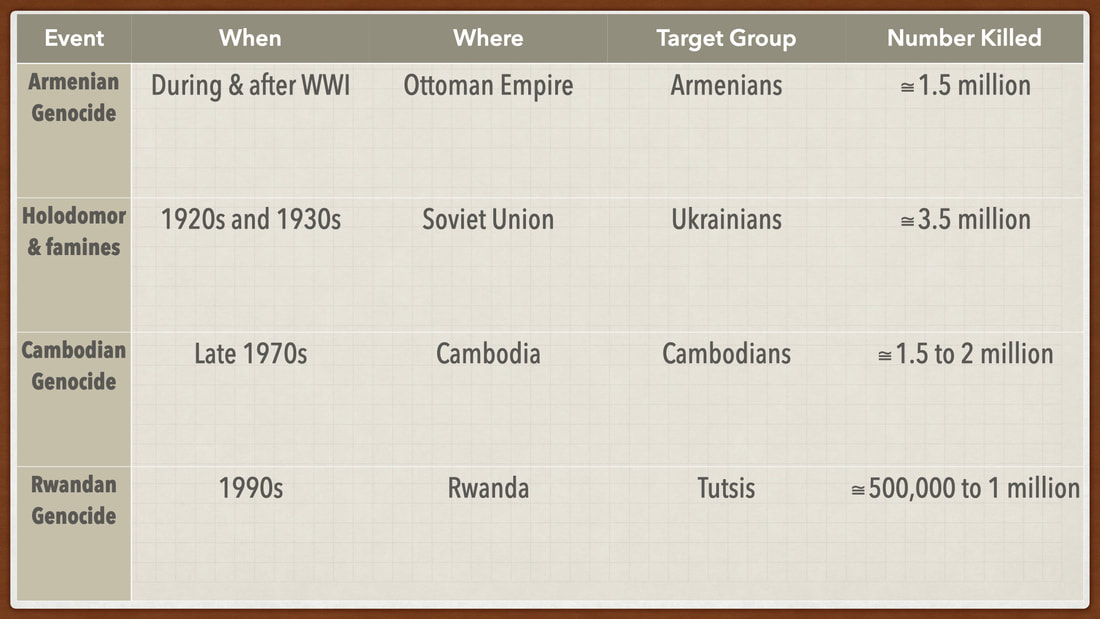7.1 Shifting Power After 1900
Thanks to industrialization and overseas colonization, most of the Western Hemisphere - including Great Britain, France, and the Netherlands - dominated the global political order. Old land empires (Ottomans, Austria-Hungary, Russian Empire, and the Qing Dynasty later on) were replaced by new rising powers like Japan (post-Meiji Restoration) and the US (which recently acquired the Philippines, Puerto Rico, and Guam).
After the World Wars, former colonies ultimately created their own independent nations and states by the end of the 1900s either through peace or bloodshed. They mostly resulted from internal and external challenges to existing orders in politics and societies: dissatisfaction with leaders, foreign invaders, conflicts between social classes, and revolutions. Due to the anti-colonial sentiments expressed by locals through uprisings and revolutions, the imperial model of government was proven to be ineffective. As a result, its prevalence dropped by the 1900s. Even up to this day, we hear about “countries” or “nations,” not “empires.”
7.2 Causes of World War I
World War I - known as the Great War in 1914 - was sparked by multiple causes, including an immediate cause that served as the final push towards escalation.
Militarism
|
Militarism refers to the build-up of a country’s arms and firepower to outpace neighboring nations in military might. Industrialization further intensified this process as each nation produced vast arsenals of deadly weapons ranging from mustard gas to flamethrowers within a span of months or years. One key instance is the naval build-up between Great Britain and Germany during the early 1910s. After Germany was successful in building enough Dreadnoughts (battleships) to make a fleet, the British ordered the production of twice as many battleships as a countermeasure to prevent the Germans from invading them. The back-and-forth increase in military expenditures and weapons between the two raised fears of a massive conflict in Europe. By 1914, anxiety loomed over the entirety of Europe and all European powers were ready for war.
Alliances
|
|
Unlike continents with fewer countries like North America, European states have been historically brawling due to their close proximity. The pecking order has shifted throughout time as political stability on a regional scale for long periods is nearly impossible. To avoid constant worries about invasions from all sides and tip the balance of power to their favor, nations established alliances with their neighbors. Alliances not only offered guaranteed safety and protection from member states but also stimulated trade between them. By World War I, Europe was defined by two major alliances. Theoretically, the alliance system prevented nations from making reckless actions at the risk of incurring the wrath of the entire alliance, but these entangling alliances have an adverse effect. Once war begins, it cannot be an isolated incident; it will spread throughout Europe.
|
Imperialism
|
Imperialism is undoubtedly one of the main causes of World War I. Even with the risk of endangering alliances and bloodshed, many European countries were eager to expand and gain resources abroad. The scramble for colonies in Africa destroyed the balance of power established by the Congress of Vienna as some European nations acquired more overseas territories than the others. While imperialism did not immediately cause the war, it was the medium that caused the Great War to become a true World War as battles were fought not only in Europe but also in Asia and Africa with immense and devastating consequences.
|
Nationalism
Growing nationalist sentiment fed fuel to the fire of militarism and the desire to use weaponry to expand the glory of the state and its people. Nationalism destabilized ethnically diverse nations such as Austro-Hungary and Serbia because certain ethnic groups within the state clamored for an independent country made up of their people and only their people, completely separate from the rest of the bunch whom they considered different. This was the direct motivation behind the catalyst of World War I.
The Assassination of Franz Ferdinand
|
Unfortunately, things went further downhill from this point. Angered by the archduke’s death, Austria-Hungary, backed by Germany, demanded that Serbia hand over Princip and his co-conspirators alongside nine other unreasonable requests, some of which alluded to Austria’s desire to take over the Balkans. After Serbia refused to comply, Austria-Hungary declared war. Neighboring Russia was a Serbian ally; in response, Russia mobilized its forces. When it ignored Germany’s demands to stop, the Germans finally joined the fray on Austria-Hungary’s side.
|
|
On June 28, 1914 Austro-Hungarian archduke Franz Ferdinand was assassinated while parading through Sarajevo (a Balkan state) with his wife. The perpetrator of the bold and heinous crime was Gavrilo Princip, a Serbian nationalist who was part of a terrorist group called the Black Hand. The Black Hand's ultimate goal was to create an independent Serb state and eliminating the archduke was supposedly the first step towards achieving that dream.
Great Britain sided with Russia and Serbia after Germany invaded Belgium (a British territory) to get to a fully-mobilized France. Japan, through its military alliance with the British, joined the war on their side weeks later. The Ottoman Empire, the United States, and other European states followed suit much later. By the end of 1917, countries around the globe were involved. |
7.3 Conducting World War I
World War I was the first global conflict that is globally acknowledged as a form of total war - one in which everyone’s a target, any weapon is permitted, and the scope of the battlefield is unlimited. WWI was unique in terms of conducting war, the amount of devastation, and the types of military technology used.
A Two-Front War
|
Germany was at war with Russia and France, as well as their allies. Unfortunately, this put Germany in a tough spot because it is flanked by France on its west and Russia on its east. Aware of this disadvantage, experts crafted what is known as the two-pronged Schlieffen Plan. The goal of the plan was to defeat France first, and then invade the still-industrializing Russia since it was delayed in mobilizing all its forces.The plan completely fell through as the Germans underestimated the power of the French. By the time Russia was able to consolidate and deploy its troops, Germany still hadn't defeated France. As a result, Germany had to fight on two fronts: the Western Front and the Eastern Front.
|
New Military Technology
Throughout world history, those with better technology have been the victors. With the world still recoiling after the explosion of industrialization less than a century before the outbreak of WWI, nations focused on developing better weapons than existing ones as they hoped to swiftly close the war and reduce human and economic losses. Underground trench systems were established by both sides along the eastern and western fronts to protect troops from artillery and gunfire from above the ground, which in turn created “no-man’s lands.” The name refers to the areas between trenches because of those going into them having near-zero chances of survival due to the possibility of being mortally wounded or killed by either ally or foe.
|
Some of the new military technologies of WWI were:
|
The Home Front
During times of war, a country's economy shifts becomes heavily focused on the production of weapons, ammunition, and aid packages alongside more supplies that willl aid troops abroad. The Home Front refers to everything the government does to support the nation’s cause in war. People rationed their supplies. Governments created production quotas. Women worked in place of men in factories and industries. Dissent was crushed through censorship and strict punishments.
|
To encourage intense and fervent nationalism and to avoid opposition that might hinder war efforts, governments resorted to political propaganda, any art or media that promotes local support against a cause or enemy being degraded in such works. Throughout any modern conflict, propaganda is not necessarily accurate. Instead, it imparts a political message that clearly defines the good guys and bad guys; it also pushes the people to help the good guys win the war.
Many British or American propaganda posters from WWI look down on the Central Powers. One example from the United States portrays the Central Powers as an ape instead of human; the barbaric animal is clutching Lady Liberty in its arms, a possible view that American ideals were threatened. The poster motivates the people (its audience) to step up and join the war effort by working at factories and sending supplies to vanquish the “apes” once and for all. Interestingly, the United States produced higher numbers of propaganda posters during WWI more than any other belligerent.
|
On November 11, 1918, an armistice was declared as the German defenses crumbled. The victorious Allies met in France as part of the Treaty of Versailles, a postwar conference in which spoils were split and losers were penalized with reparations (war payments) and dissolution/reduction of territories. The immediate threat was over, but Europe became significantly weaker than ever before due to economic problems induced by wartime commitment: inflation, debts to creditor nations like the US, and loss of investments overseas.
7.4 Economy in the Interwar Period
The Great Depression
|
Once World War I ended, Europe was stuck in a vicious chain of debt. The former Allied forces owed each other for equipment and reinforcements during the war; but for them to be able to repay each other, they had to depend on reparation payments from Germany and Austria, which in turn relied on loans from the US. Seeing the amount of destruction and loss the continent had suffered, foreign investors withdrew their capital and strained the financial system of the region.
Meanwhile, industrialization had permanently changed the cycle of production. The drastic increase of supplies for raw materials reduced global demand, hitting exporters and economies that primarily relied on their production the hardest. The return to normalcy of production by warring countries also left excessive surpluses of products, causing factories to slow (or even stop) production for the time. As a result, prices lowered and unemployment rates increased with companies laying off workers.
|
By 1929, the US’s industrial boom came to an abrupt end when the stock market crashed with investors scrambling to sell their stocks. Thousands of Americans watched helplessly as their life savings dropped to zero. Businesses and banks failed and unemployment rates were at their highest. The economic connection of the US to the rest of the world in terms of role in WWI and exportation/importation started to create a ripple that truly made the Great Depression a global one.
Government Intervention in the Economy
|
The Great Depression exposed the weaknesses of the old capitalist system. It served as a wake-up call for nations to change their economic strategy in order to rise again. While most nations assumed that this plague would disappear by itself, the prolonging of the depression eventually compelled governments to directly and actively intervene to save the economy.
Economist John Maynard Keynes pioneered Keynesian economics set of theories which states that governments MUST stimulate the economy by spending and funding public works projects. Those projects would then lower unemployment rates by providing jobs and reinvigorating consumer spending. US President Franklin Roosevelt (FDR) used this theory as a model for his New Deal. The New Deal created a social welfare state and triggered social reform before ultimately ending the Great Depression through massive spending during WWII.
|
|
Alternative methods were implemented in the Soviet Union (Russia) and Italy. After the civil war that caused Russia to withdraw from WWI, communism became the norm in the region. Large industries, banks, and private businesses continued to operate under state control under Vladimir Lenin’s New Economic Policy. After his death, Joseph Stalin’s ambitious vision replaced the NEP with his Five Year Plans to catch up with industrial powers in the west. Under this policy, the process of industrializing steel and machinery came first before consumer goods. To drive industrialization, he collectivized agriculture as cooperative farm units; profits were shared by every farmer. Farmers were expected to promote agricultural productivity by meeting production quotas every 5 years. Those who did not meet these goals were severely punished and sent to labor camps (gulags).
In Italy, Benito Mussolini spearheaded the fascist corporatist economy. Corporatism (key word: corporate) emphasized state control over private companies and industries serving as the means of production. A national council settled disputes over labor, wages and capital, and natural resources. Theoretically, this style of economics united the interests of the state, workers, and employers and minimized the influence of labor unions.
7.5 Unresolved Tensions After World War I
Like the Great Depression, World War I only solved the immediate problem of conflict over European imperialism and power. For the most part, unresolved tensions remained and secondary problems even emerged from the postwar negotiations in France. In the Paris Peace Conference, President Woodrow Wilson presented his Fourteen Points, which included the end of colonialism, reduction of arms, free trade between countries, and self-determination in former territories by major powers. However, this proposal was shot down, and as a result, the dejected US established an isolationist policy after the cold treatment of their Atlantic neighbors moving forward.Key conflicts within this Interwar era concerned some of Wilson’s statements.
Japanese Imperialism
|
Japan was a rising star during WWI as it secured sea lanes based on its position on the side of the Allies. Even before that, it had proven itself to be a formidable force to reckon after defeating China and Russia in previous conflicts (Sino-Japanese Wars, Russo-Japanese Wars). Japan's expansion continued after the war.
During the Great Depression, military leaders were convinced that the only way to get out is to revert to being an empire and invade neighboring territories. Already having Korea and parts of China under its belt, Japan invaded Manchuria and renamed it as Manchukuo. The League of Nations wasn't able to do anything but watch Japan expand its reach and destroy everything in its path. The notorious Rape of Nanjing (1937) showed the worst side of humanity as the Japanese slaughtered hundreds of thousands and pillaged cities and villages. Imperial expansion from that point continued and by World War II, Japan has consolidated East and parts of Southeast Asia under its Greater East Asia Co-Prosperity Sphere. Inhabitants of these territories grew resentful, but they only kept to themselves due to their inability to kick them out on their own. |
Right to Self-Determination
After the Paris Peace Conference, the Ottoman Empire dissolved and Germany had to relinquish control over its colonies. Under British, French, and other Allies’ control, these former colonies are known as mandates.
Unlike colonies from earlier centuries, the winning countries ruled these areas under the justification that they are doing so until they are ready to “self-determine” (self-rule) for themselves. Locals were resentful due to their rising nationalism.
Unlike colonies from earlier centuries, the winning countries ruled these areas under the justification that they are doing so until they are ready to “self-determine” (self-rule) for themselves. Locals were resentful due to their rising nationalism.
Anti-Imperial Resistance
To counter imperialism, transnational movements emerged. Two movements in particular gained traction in their respective regions. Pan-Africanism called for the union of every African group regardless of their current location (within Africa or abroad). Pan-Arabism likewise echoed the desire of Arabs to be under a single, unified nation.
Increased literacy rates led to the formation of nationalist organizations that called for independence within European colonies. The Indian National Congress, formed by Mohandas Gandhi, called for Britain’s peaceful departure from India through negotiated independence. West Africa conducted continuous strikes and established congresses to symbolize African resistance to French rule.
Due to the failure of Wilson’s Fourteen Points, the status quo remained unchanged in terms of imperialism. There was, however, a slight change that intensified during and after World War II: nationalism within mandates and colonies.
7.6 Causes of World War II
Unlike World War I, World War II didn’t start because of the assassination of a significant leader. However, we can pinpoint its spark to both recurring and new causes alike. Some of them are similar to WWI’s, such as militarism and imperialism, but others are unprecedented like economic downturns and the rise of totalitarianism.
Global Economic Crises
The Great Depression led to the collapse of countless governments across the world, especially the US and Western Europe. The lack of government activity spawned chaos and resentment among locals who called for action. Even after these sentiments were alleviated by the eventual end of the crisis, it is actually the main reason behind Adolf Hitler’s rise to power. His platform was to use imperialism as a way to restart Germany’s economy. Recently appointed Chancellor of Germany, Hitler's bold promises to get Germany out of reparation payments (WWI) and become a leading power in Europe won over the German populace who felt bitter and cheated as the main group held accountable in the Treaty of Versailles.
Unsustained Peace After WWI
The Paris Peace Conference failed to solve the problems of imperialism and proper accountability, leaving the former Allies and Central Powers in very awkward political and diplomatic situations. The existence of mandates gave Hitler a reason to justify his invasions of German-speaking regions as a form of unifying his people - the “superior race” - under one flag. Italy also felt left out in the reward distribution of the Versailles Treaty, hardly receiving any territories despite fighting for the Allies during WWI. This ultimately sparked nationalism and ambitions to acquire what they weren’t able to before under Benito Mussolini. In the same decade, Italy had already risen as a fascist dictatorship, clear evidence that the peace settlement was hardly effective in the long run.
Rise of Fascism & Totalitarianism
Fascism and totalitarianism proliferated and expanded mainly due to two reasons: unhappiness with the peace settlement of WWI and the global economic crisis. Germany felt humiliated and cheated by the fact that they were the first to blame despite the fact that they only supported Austria-Hungary against Serbia, the first two countries who actually declared war against each other. The Great Depression and the global economic crisis also created motives for fascism. Capitalism is clearly not the most effective economic system even after the war. Mussolini and Hitler sought alternatives, and they found their niches within fascism and Nazism (a form of fascism), respectively, to avoid a repeat of the depression that killed, starved, and crippled millions worldwide.
|
Hitler began to mobilize German forces, in direct response to the rise of Nazi totalitarianism and staunch nationalism motivated by revenge against the Allies and personal justice. A total of 13.6 million troops served Nazi Germany throughout the course of WWII. He also ordered the swift construction of naval destroyers as a show of might. Neighboring countries started to be concerned about Germany’s rapid mobilization, but they chose to remain passive with the hopes of it ending soon. Previous adversaries like France and Belgium issue warnings for Hitler to stop to no avail.
|
Imperialism
|
During the Interwar Period, Japan consolidated its hold over Asia. Years before WWII started, it entered the Berlin Pact with Fascist Italy and Nazi Germany - a symbol of their agreement on solidarity, allied assistance, and splitting the bounty after the war. Known as the Axis Powers, they resolved to acquire more land and create a new balance of power that centers on their tripartite axis.
With allies at his side, Germany proceeded to annex Austria (Anschluss) in March 1939 to everyone’s shock. France and Britain condone this as a form of appeasement in exchange for Hitler’s word on not invading any territory any further. When he violated this promise by invading Poland in September 1939, the two western European countries finally realized that there’s no other way around and promptly declared war on Germany. After 20 years of uncertain peace, the world was at war again. |
7.7 Conducting World War II
World War II, like World War I, was a total war. Colonies of the Allied Powers, such as India (Britain), also joined the war, making it a truly global conflict on a much greater scale than WWI as it included more countries in Asia, Africa, Europe, and even the Americas.
Western Democracies
Under Winston Churchill’s leadership, Great Britain remained unfazed by Germany’s blitzkrieg tactics. His military ingenuity allowed him to hold off Hitler’s forces after the fall of France in 1940 despite being close to the defeated nation. Churchill’s determination to not let Britain fall motivated him to forge an alliance with Franklin Roosevelt and the US, officiated after the latter joined the war in response to Japan’s bombing of Pearl Harbor in December 1941. Under the Lend-Lease Act, both countries were able to share (US lending Britain) war materials, weapons, and equipment necessary for repelling the Axis Powers.
Franklin Roosevelt took advantage of the war to mobilize the United States’s undamaged factories and ramp up their production of everything from ammunition to aircraft. By doing so, he gave the American economy the boost it needed, enough to get the US out of the Great Depression. Like WWI, women were given ample opportunities in the job market and production rates were at all-time highs once again. The US also led the liberation efforts in the Pacific, which was the other major war theatre, against Japan through an “island hopping” strategy.
Franklin Roosevelt took advantage of the war to mobilize the United States’s undamaged factories and ramp up their production of everything from ammunition to aircraft. By doing so, he gave the American economy the boost it needed, enough to get the US out of the Great Depression. Like WWI, women were given ample opportunities in the job market and production rates were at all-time highs once again. The US also led the liberation efforts in the Pacific, which was the other major war theatre, against Japan through an “island hopping” strategy.
Totalitarian States
In terms of logistics, morale, and productivity, totalitarian regimes fell behind in mobilization efforts. Attitudes and policies made their war machines less effective as time went on.
|
Joseph Stalin’s Soviet Union was already weakened by the Five Year Plans. The purges within farmer groups and communist party officials also eliminated some of the most brilliant military strategists in Russia. To add insult to injury, a miscommunication between Stalin, Churchill, and Roosevelt delayed reinforcements to the eastern front of the European theatre, leading to millions of Soviets dying before his two allies’ reinforcements could finally arrive.
Propaganda and art were used heavily by both western democracies and totalitarian states, but primarily by the totalitarian states. Hitler’s Nazi Germany made use of nationalist propaganda to motivate German youth to participate in the war as an honorable and glorious notion. Anti-Semitic art was also spread throughout the country, a chilling precursor to one of the most tragic series of events of history: the Holocaust. |
Technology & Tactics of War
|
World War II featured upgrades of previous weapons. Tanks, for instance, are now better adapted to more environments. More varieties of firearms are used based on the range of combat, and atomic weapons such as those infamously dropped on Hiroshima and Nagasaki have destructive capabilities hundreds of times deadlier than the classic mustard gas from WWI.
WWII is also the first conflict where civilians were purposely targeted as part of long-term military strategies in war. To encourage surrender, cities in Japan (Tokyo, Kobe) and Germany (Hamburg, Dresden) were continuously bombed, killing people by the thousands. With the development of technology came higher casualty rates, clear indicators of the inevitability of death and destruction in extreme times like war. |
7.8 Mass Atrocities
Atrocities depicting the dark side of humanity did not stop at the Rape of Nanjing or any other vicious war crime before that. Genocides and other acts of ethnic violence were committed to destroy specific groups, races, and/or populations, often viewed as inferior based on hierarchical principles such as Social Darwinism.
The Holocaust
One of the most notorious instances of mass violence was the Holocaust. In history, it goes down as the worst outbreak of anti-Semitism, claiming the lives of 6 million Jews. Before the peak of World War II, Hitler forcibly expelled the Jewish communities out of Germany. Within Germany, Jews suffered in a multitude of ways:
- Children were picked on and excluded in schools.
- Adults were blacklisted from getting jobs.
- On Kristallnacht (night of broken glass), Jewish houses and businesses were trashed, burned, and destroyed.
- Jews were segregated in their own communities.
Things worsened as Hitler implemented his final solution: the extermination of all Jews. Jews and their families were rounded up and brought to concentration camps (the most infamous one being Auschwitz). They were overworked and starved to death. Most perished in gas chambers and methodical executions routinely conducted by Germans.
As Allies from both sides advanced to Germany, they were horrified by the sights of the concentration camps spread out across Germany and Poland. Up to this day, memorials and commemorations are still conducted in honor of those who survived and perished during the Holocaust.
As Allies from both sides advanced to Germany, they were horrified by the sights of the concentration camps spread out across Germany and Poland. Up to this day, memorials and commemorations are still conducted in honor of those who survived and perished during the Holocaust.
Other Mass Atrocities of the 20th Century
